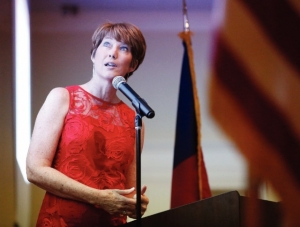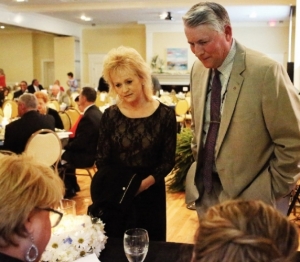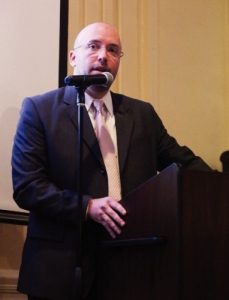Seymour Johnson Air Force Base is praised for resiliency during gala
By Joey Pitchford
Published in News on March 26, 2017 12:00 AM

News-Argus/CASEY MOZINGO
Keynote speaker Kathleen Ferguson looks at the screen as she reads "What does the Air Force think about Seymour?" during the annual Friends Of Seymour Johnson Air Force Base held Saturday at the Goldsboro Event Center. Ferguson is with the Roosevelt Group, which also made a presentation at the event.

News-Argus/CASEY MOZINGO
Grey and Gloria Morgan check in at before the annual Friends of Seymour Johnson Air Force Base gala Saturday night.

News-Argus/CASEY MOZINGO
Military Affairs Committee chair Scott LeFevers gives his welcome speech before dinner.
People often ask Kathleen Ferguson what the Air Force thinks of Seymour Johnson Air Force Base.
According to Ms. Ferguson, who spoke at the 2017 Friends of Seymour Johnson Air Force Base gala Saturday, not much of anything.
That is not to say that Seymour is viewed unfavorably by any stretch, only that it is difficult for the Air Force as an organization to have an opinion on something.
Ms. Ferguson, a nationally recognized expert in civil engineering and military installation needs who spent over 30 years in the Air Force, said the Air Force rarely focuses so closely on a particular installation except in large-scale issues such as base realignment and closure (BRAC).
"The Air Force really doesn't think about Seymour Johnson, they really don't," she said. "Every individual member in the Air Force has their own opinion, including many great senior leaders who have been here and served many years in the Air Force here, but as an organization the Air Force doesn't have much of an opinion unless there's something big like BRAC."
In lieu of a sweeping Air force opinion, Ms. Ferguson offered her own. As a member of the Roosevelt Group, a Washington, D.C., consulting group which works with Seymour Johnson, Ms. Ferguson praised SJAFB for its resilience during years of military budget reductions.
Turning to a presentation slide projected next to her, Ms. Ferguson compared numbers from the Air Force when she joined in 1981 and today. The annual budget then was $46.3 billion, compared to $120.4 billion today, which she said was still not enough for the branch. While the budget has increased, overall active duty personnel have declined, with 564,000 in 1981 and 317,000 now.
Despite those changes, Seymour Johnson's numbers remained relatively stable. The base has also been a staging area for new air power, having received the F-15E Strike Eagle when the jets were brand new.
This trend is expected to continue, as Seymour Johnson and the 916th Air Refueling Wing have been identified as the preferred alternative for the new KC-46a Pegasus refueling tanker. While the final decision on where to base the aircraft has not been made yet, Ms. Ferguson said to expect a concrete decision within the next three months.
Ms. Ferguson challenged the audience to look ahead with those numbers in mind.
"What is the Air Force going to look like in 2025, in 2030," she said. "And that's really what I want you all to think about, what is Seymour Johnson going to look like in the future?"
Another statistic Ms. Ferguson highlighted was the increased integration of airmen into communities surrounding bases. While in 1981 the majority of airmen and their families lived on base, around 80 percent now live off base, which Ms. Ferguson said is valuable in creating connections between the Air Force and the civilian population.
Moving forward, Ms. Ferguson asked the audience not to get complacent with their work for the base. She compared the people in the room to those who worked to get the base reopened in the 1950s.
"Thank you, thank you for everything that you're doing, thanks for everything that you've done to support the airmen that have been here since WW II," she said. "There was a short break in time for about 10 years when the base closed and reopened I think in 1956 or 1957, and it was based on people just like you sitting in a room in the 50s that caused Seymour Johnson to open again."
Earlier in the evening, Roosevelt Group managing partner John Simmons briefed the audience on some of the advocacy projects they have been working on in Washington, including military construction funding and blocking wind farms that could potentially interfere with Air Force operations.
He also went in to details of President Donald Trump's agenda, including what he refereed to as "chaos" in the National Security Agency and the failed Republican bid to repeal and replace the Affordable Care Act.
Out of 553 NSA positions the president must nominate people for, 492 have not been nominated, Simmons said. He attributed this to a lack of experience in the people President Trump has brought with him to the White House.
He also said that people should not expect any large, sweeping tax reforms, as lawmakers were banking on the repeal of the ACA to free up funds for tax cuts.
Simmons said that military funding would go up in the president's proposed budget, but that the budget would be a "non-starter" with Congress because it provides those funds by taking money from domestic programs.
However, he said, with emerging threats like Iran, Syria and North Korea, the demand for cutting-edge air power only figures to increase.
